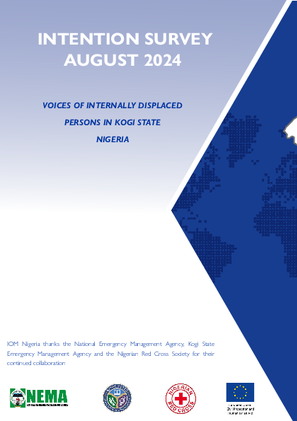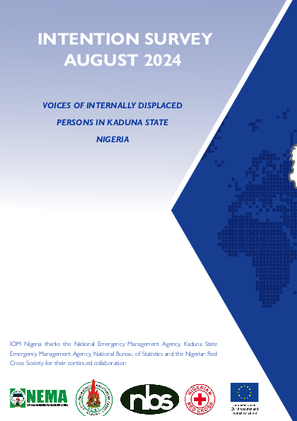-
Countries
-
Data and Analysis
-
Special Focus
-
Crisis Responses
Compilation/Overview
Color
white

Contact
iomnigeriadtm@iom.int
Language
English
Location
Nigeria
Period Covered
May 15 2024
Jun 11 2024
Activity
- Survey
- Return Intention
To ascertain the future intentions and aspirations of the IDPs in Katsina State, the DTM surveyed 33 LGAs where IDPs were situated. Out of the 32,281 displaced households in the state, 3,587 were interviewed. Among the households interviewed, two per cent of the respondents resided in camps and camp-like settings, while 98 per cent resided in host communities.

Contact
DTM Nigeria, iomnigeriadtm@iom.int
Language
English
Location
Nigeria
Period Covered
Apr 15 2024
May 11 2024
Activity
- Survey
- Return Intention
The issue of internal displacement in north-west and north-central Nigeria has persisted for over a decade, with a significant population of 1,092,196 people remaining displaced for extended periods. Many of these internally displaced persons (IDPs) still wish to return to their places of origin, stay in their current locations, or relocate to new areas. To better understand the IDPs' preferred durable solutions—whether voluntary return, local integration, or relocation—the Dis-placement Tracking Matrix (DTM) conducted the Intention Survey (IS). This survey was carried out between April and June 2024, targeting 17,833 internally displaced households across 181 Local Government Areas (LGAs) and 794 wards in ten states in north-west and north-central Nigeria: Benue, Kaduna, Kano, Katsina, Kogi, Nasarawa, Niger, Plateau, Sokoto, and Zamfara.
The survey aimed to highlight the aspirations of IDPs regarding their preferred durable solutions over the next 12 months, thereby supporting evidence-based decision-making, policy development, and program planning. A durable solution is achieved when IDPs no longer require specific assistance and protection due to their displacement and can enjoy their rights without discrimination. The survey assessed intentions such as 'return to the place of origin,' 'integrate into the current location,' or 'relocate to a new location' as indicators of the IDPs' preferred solutions.

Contact
DTM Nigeria, iomnigeriadtm@iom.int
Language
English
Location
Nigeria
Period Covered
Apr 15 2024
May 11 2024
Activity
- Survey
- Return Intention
To gain insight into the future intentions and aspirations of the IDPs in Plateau State, the DTM surveyed 15 LGAs where IDPs have been located. Out of the total 9,272 displaced households in the state, a sample of 1,326 was interviewed. Of these households, two per cent were residing in camps or camp-like settings, while the overwhelming majority, 98 per cent, were residing within host communities.

Contact
DTM Nigeria, iomnigeriadtm@iom.int
Language
English
Location
Nigeria
Period Covered
Apr 15 2024
May 11 2024
Activity
- Survey
- Return Intention
To discern the future aspirations and intentions of IDPs in Nasarawa State, the DTM surveyed thirteen (13) LGAs where IDPs were situated. Out of the total 3,989 displaced households in the state, a sample of 660 were interviewed. Of these households, 10 per cent were found to reside in camps or camp-like settings, while the overwhelming majority, 90 per cent, resided within host communities.

Contact
iomnigeriadtm@iom.int
Language
English
Location
Nigeria
Period Covered
Apr 15 2024
May 11 2024
Activity
- Survey
- Return Intention
To understand the future intentions and aspirations of IDPs in Kogi State, DTM surveyed eight (8) LGAs where IDPs were situated. Out of the 1,944 displaced households in the state, 209 were sampled and interviewed. Among the households interviewed, 33 per cent resided in camps or camp-like settings, while the remaining 67 per cent resided in host communities.

Contact
DTM Nigeria, iomnigeriadtm@iom.int
Language
English
Location
Nigeria
Period Covered
Apr 15 2024
May 11 2024
Activity
- Survey
- Return Intention
To understand the future intentions and aspirations of IDPs in Niger State, DTM surveyed 13 LGAs where IDPs were situated. Out of the total 3,447 displaced households in the state, 532 households were sampled and interviewed. Among the households interviewed, five per cent resided in camps or camp-like settings, while the remaining 95 per cent, resided in host communities.

Contact
DTM Nigeria, iomnigeriadtm@iom.int
Language
English
Location
Nigeria
Period Covered
Apr 15 2024
May 11 2024
Activity
- Survey
- Return Intention
To ascertain the future intentions and aspirations of the IDPs in Sokoto State, the DTM surveyed 21 LGAs where IDPs were situated. Out of the 17,454 displaced households in the state, 2,317 were interviewed. Among the households interviewed, 17 per cent were situated in camps and camp-like settings, while the remaining 83 per cent were settled in host communities.

Contact
iomnigeriadtm@iom.int
Language
English
Location
Nigeria
Period Covered
Apr 15 2024
Jun 11 2024
Activity
- Survey
- Return Intention
To ascertain the future intentions and aspirations of the IDPs in Kano State, the DTM surveyed 32 LGAs where IDPs were situated. Out of the 2,642 displaced households in the state, 512 were sampled and interviewed. Among the households interviewed, two per cent of households were situated in camps or camp-like settings, while 98 per cent were residing in host communities.

Contact
DTM Nigeria, iomnigeriadtm@iom.int
Language
English
Location
Nigeria
Period Covered
Apr 15 2024
May 11 2024
Activity
- Survey
- Return Intention
To ascertain the future intentions and aspirations of the IDPs in Zamfara State, the DTM surveyed 13 LGAs where IDPs were situated. Out of the 23,668 displaced households in the state, 2,366 were interviewed. Among the households interviewed, 10 per cent resided in camps and camp-like settings while the remaining 90 per cent were situated in host communities.

Contact
iomnigeriadtm@iom.int
Language
English
Location
Nigeria
Period Covered
Apr 15 2024
May 11 2024
Activity
- Survey
- Return Intention
To ascertain the future intentions and aspirations of the IDPs in Kaduna State, the DTM surveyed 22 LGAs where IDPs were situated. Out of the 20,766 displaced households in the state, 2,447 were interviewed. All IDP households interviewed reside in host communities. There were no IDP households that lived in camps or camp-like settings in the state.
Pagination
- Page 1
- Next page
